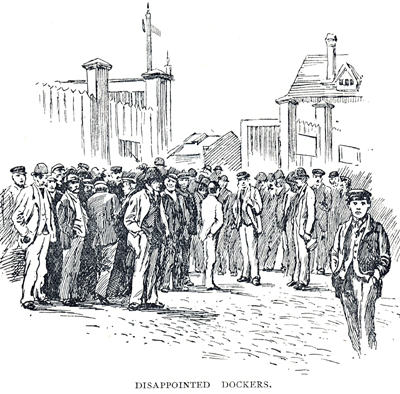As part of Essex, businesses and homes on the eastern bank of the Lea were not covered by the much stricter London planning regulations introduced in the 1844 Metropolitan Building Act. This attracted to Canning Town what Charles Dickens described in 1857 as “offensive trade establishments …. oil-boilers, gut-spinners, varnish-makers, printers’ ink-makers and the like” (from “Londoners over the border” in Charles Dickens’ weekly journal Household Words). This included chemical companies and other foul-smelling industries. The shipbuilding company Thames Ironworks, founded in 1837 by shipwright Thomas J. Ditchburn and naval engineer Charles J. Mare, also became a major local employer after opening premises on the Essex side of the Lea in 1847.
In the beginning, Canning Town was divided into ‘Hallsville’ in the south (initially named ‘Plaistow New Town’), where the shipbuilding workers and their families were housed, and ‘Canning Town’ in the north, where the workers who were building the Royal Docks lived. In 1851, ‘Canning Town’ consisted of 60 houses in Stephenson Street, Wharf Street and Wharf Place, while ‘Hallsville” consisted of about 80 houses close to Victoria Dock Road. Canning Town, as the whole area soon became known, was possibly named after the 1st Viceroy of India, Charles John Canning —known as ‘Clemency Canning’ for his leniency in dealing with the Indian mutiny in 1857. However, Canning himself had no connection with East London and the name of the ‘town’ existed long before the mutiny. The lack of planning regulations attracted small landlords in pursuit of easy profits, so there were no roads, pavements, drains or gas supply. The houses were built seven feet below high tide level, next to earth river embankments that may originally have been constructed in Roman times. Inevitably the houses were damp and often flooded, the water spreading sewage and therefore disease. It was only in 1855, after a cholera epidemic, that Canning Town was given a clean water supply — previously residents had to use water from the ditches into which raw sewage was discharged.
After the opening of the Great Eastern branch railway line between Stratford and North Woolwich in 1846, and the opening of the Royal Victoria Dock in 1855, Canning Town expanded rapidly and densely across Plaistow marshes. Most people now moved to Canning Town to work in the docks, or in businesses related to the docks. In 1881, two out of three of the population of the borough of West Ham had been born elsewhere. The population doubled again between 1881 and 1901, and by 1911 nearly 300,000 people lived in the borough, making it the seventh most highly populated borough in England. The area had a higher proportion of children in the community than anywhere else in England. The population was also the most multi-cultural in Britain, including people from Ireland, Germany, India, Malaysia, China and Japan and from a wide range of Eastern European, African and West Indian countries.
Local employers also organized a range of activities. Arnold Hills (1857-1927), who became managing director of Thames Ironworks in the 1890s, was committed to providing facilities for his workers in their leisure time. He even lived among the workers in Canning Town for five years in order to develop clubs and recreational centres. Hills became famous as a philanthropist and voluntarily introduced an eight-hour day for his workers, although his actions in employing non-union labour to break a strike meant that there were always tensions between him and his employees.
Hills’ most famous action was to found a football team at the Ironworks in 1895, together with his foreman Dave Taylor. A keen footballer himself, Hills even built a stadium in Memorial Ground at a then-astronomical cost of £20,000. Hills resigned from the club’s board in 1900 because of a dispute about ‘professionalising’ the team, at which point the team renamed themselves West Ham United. Today, their origins at the Ironworks are remembered in their crest of crossed riveting hammers, their nicknames of ‘the Hammers’ and the cry ‘Come on you Irons’.
The closure of Thames Ironworks in 1912 only increased the problems. By this time more than 900 ships, many of them liners or large warships, had been built by local workers for various different countries, and the site covered more than 30 acres in south Canning Town. The last ship to be built in Canning Town was the battleship HMS Thunderer, then the largest warship in the world, which was launched into the Thames in 1911.
"Disappointed Dockers" The above images and others can be found in Newham Archives at Stratford Library, and should not be reproduced without their permission. Text © Ju Gosling aka ju90 2010
|

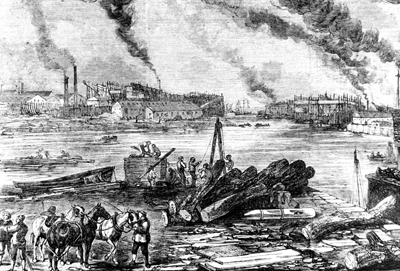
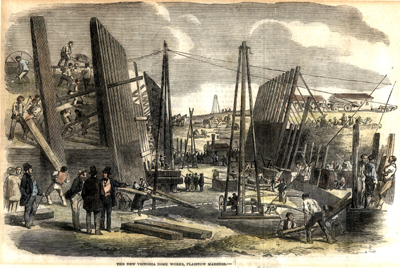
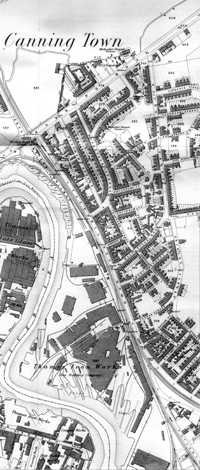 Canning
Town was founded in the first half of the 19th century on the eastern
bank of the River Lea, just before it meets the Thames. In those days
the Lea — known as Bow Creek — marked the border between
London and Essex. Until the 19th century, the only way to reach the
Essex side — then just a part of Plaistow marshes — was
by boat. Then, in 1810, an Act of Parliament was passed to allow the
Barking Road to be built between East India Docks and Barking, by James
Walker for the Commercial Road Turnpike Trust. This led to the construction
of an iron bridge across the river with a tollgate nearby, and the development
of Canning Town began.
Canning
Town was founded in the first half of the 19th century on the eastern
bank of the River Lea, just before it meets the Thames. In those days
the Lea — known as Bow Creek — marked the border between
London and Essex. Until the 19th century, the only way to reach the
Essex side — then just a part of Plaistow marshes — was
by boat. Then, in 1810, an Act of Parliament was passed to allow the
Barking Road to be built between East India Docks and Barking, by James
Walker for the Commercial Road Turnpike Trust. This led to the construction
of an iron bridge across the river with a tollgate nearby, and the development
of Canning Town began. 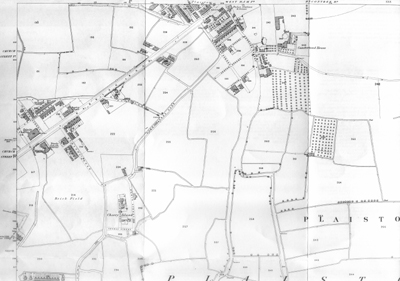 Plaistow
marshes were cut off from the rest of Essex by Barking Creek to the
west, and were rich in bird life. The marshes had been used for centuries
for grazing horses — most famously in the 18th century by the
Duke of Cumberland, brother of George III — as well as for cattle.
The notorious 18th century-highwayman Dick Turpin began his career by
stealing a pair of oxen from his employer in Plaistow: he later led
a gang of smugglers who operated between the marshes and Southend. People
working on the marshes carried special poles fitted with a flat disc
at one end to help them to jump over the many streams and drainage ditches.
At the beginning of the 19th century there were less than 200 houses
in the area, and the population of the whole of the borough of West
Ham numbered less than 7000 people.
Plaistow
marshes were cut off from the rest of Essex by Barking Creek to the
west, and were rich in bird life. The marshes had been used for centuries
for grazing horses — most famously in the 18th century by the
Duke of Cumberland, brother of George III — as well as for cattle.
The notorious 18th century-highwayman Dick Turpin began his career by
stealing a pair of oxen from his employer in Plaistow: he later led
a gang of smugglers who operated between the marshes and Southend. People
working on the marshes carried special poles fitted with a flat disc
at one end to help them to jump over the many streams and drainage ditches.
At the beginning of the 19th century there were less than 200 houses
in the area, and the population of the whole of the borough of West
Ham numbered less than 7000 people.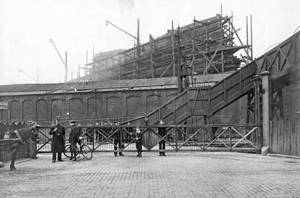
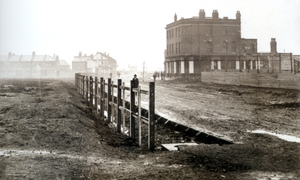
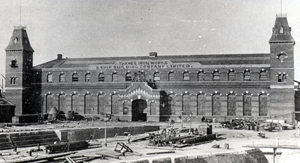
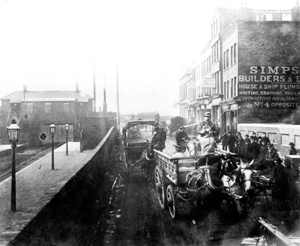




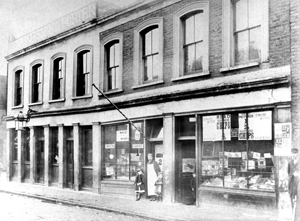

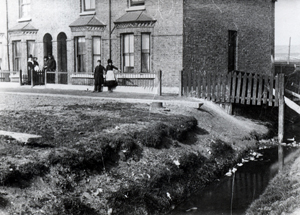
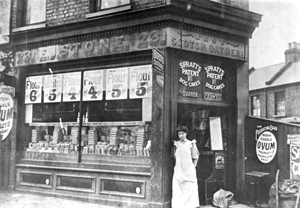 Despite
the limited incomes of the population, by the late 19th century there
were a wide range of activities available to occupy residents’
leisure time. The Barking Road was a centre for entertainment, and people
traveled up and down it by tram. North Metropolitan Tramways ran a horse-drawn
service until 1903, when West Ham Corporation Tramways took over and
ran an electrified service, with trams painted in chocolate and cream.
Despite
the limited incomes of the population, by the late 19th century there
were a wide range of activities available to occupy residents’
leisure time. The Barking Road was a centre for entertainment, and people
traveled up and down it by tram. North Metropolitan Tramways ran a horse-drawn
service until 1903, when West Ham Corporation Tramways took over and
ran an electrified service, with trams painted in chocolate and cream.
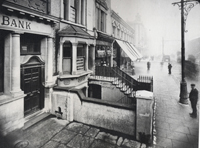 Charles
Relf opened a music hall in the Barking Road about 1875, and when he
retired as manager in 1906 it was renamed the Royal Albert Music Hall.
In 1909 it was rebuilt, partly from materials from the Imperial Theatre
at Westminster, after which it was renamed the Imperial Palace Theatre
and used as a cinema. For those who preferred to read, Canning Town
Library opened in the Barking Road in 1893 and was the first permanent
public library in the borough. The 22-acre Beckton Road Recreation Ground
(later Canning Town Recreation Ground) opened in 1894, and was similarly
the first recreation ground in the borough. Its original facilities
included a bandstand and gymnasium area, and in 1907 a large lido was
added.
Charles
Relf opened a music hall in the Barking Road about 1875, and when he
retired as manager in 1906 it was renamed the Royal Albert Music Hall.
In 1909 it was rebuilt, partly from materials from the Imperial Theatre
at Westminster, after which it was renamed the Imperial Palace Theatre
and used as a cinema. For those who preferred to read, Canning Town
Library opened in the Barking Road in 1893 and was the first permanent
public library in the borough. The 22-acre Beckton Road Recreation Ground
(later Canning Town Recreation Ground) opened in 1894, and was similarly
the first recreation ground in the borough. Its original facilities
included a bandstand and gymnasium area, and in 1907 a large lido was
added.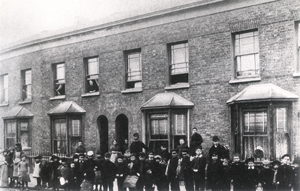
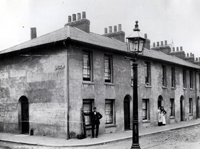
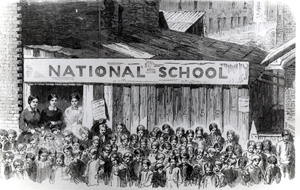
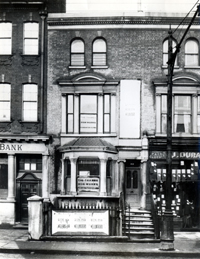
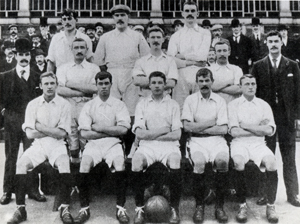 Sport
was key and Hills built Memorial Ground near West Ham station for this
purpose, including a cycle track which was extremely popular. The Ironworks
also ran a rowing club, an operatic society and other activities.
Sport
was key and Hills built Memorial Ground near West Ham station for this
purpose, including a cycle track which was extremely popular. The Ironworks
also ran a rowing club, an operatic society and other activities. 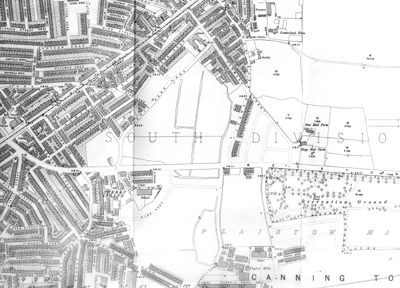
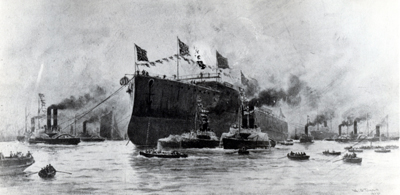
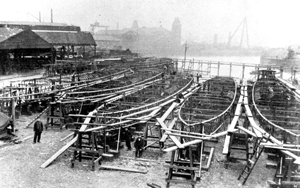 Although
officially part of Essex, in reality Canning Town was always an integral
part of London — Charles Dickens’ ‘Londoners over
the border’. Whether residents worked in the docks or other industries,
their employment was directly related to the life of the city. However,
their working and living conditions were significantly poorer than those
of their metropolitan neighbours. In 1907, more than a thousand local
residents emigrated to Australia and Canada to escape unemployment,
on the advice of the British Government.
Although
officially part of Essex, in reality Canning Town was always an integral
part of London — Charles Dickens’ ‘Londoners over
the border’. Whether residents worked in the docks or other industries,
their employment was directly related to the life of the city. However,
their working and living conditions were significantly poorer than those
of their metropolitan neighbours. In 1907, more than a thousand local
residents emigrated to Australia and Canada to escape unemployment,
on the advice of the British Government. 